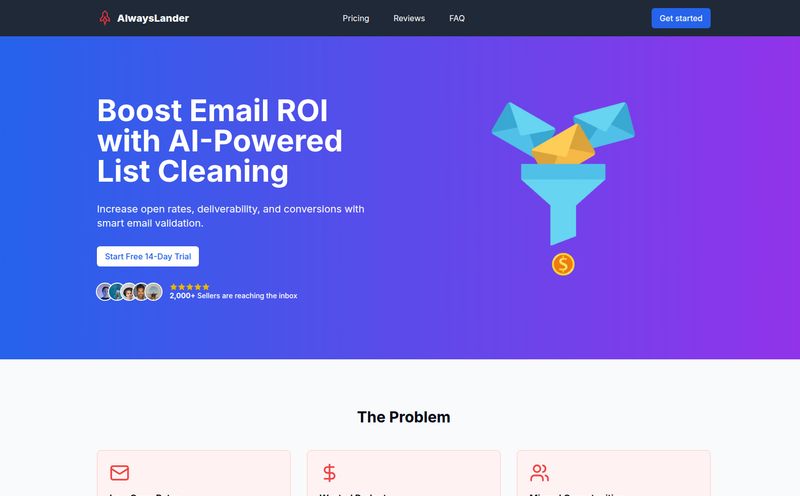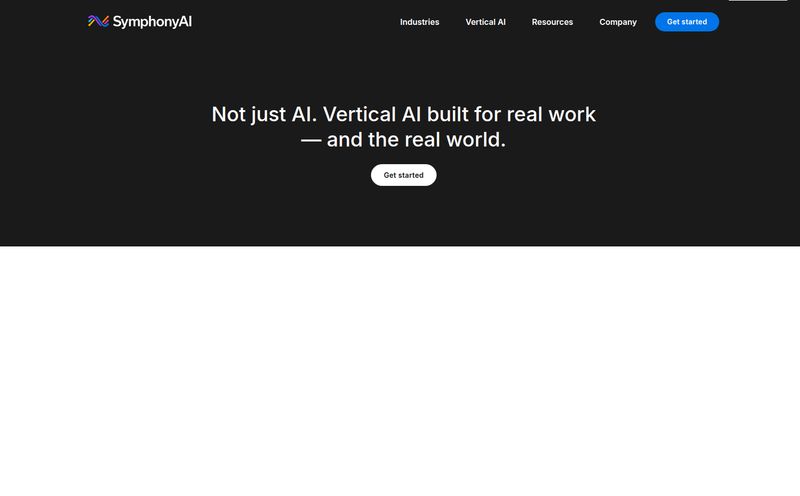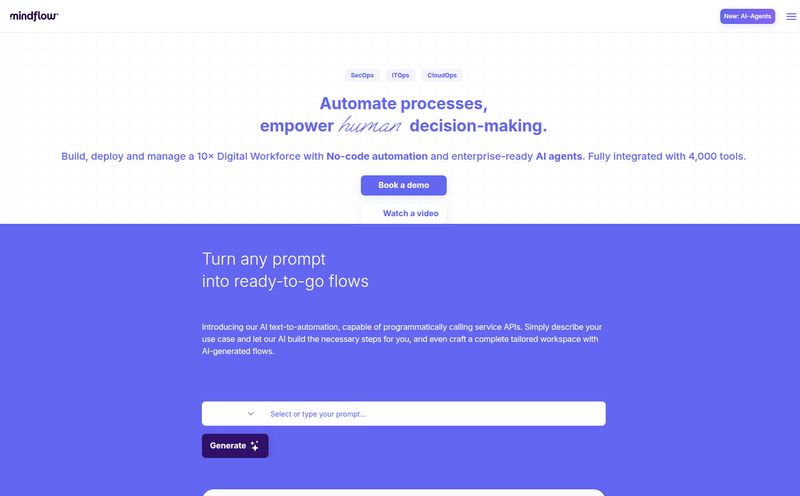We’ve all been there. You’re deep in a project, the deadline is breathing down your neck, and a client or colleague sends over the one piece of information you desperately need. But it’s not in a neat Word doc or a simple email. Oh no. It’s a 30-page scanned PDF, a grainy photo of a conference slide, or some other un-copy-paste-able nightmare.
The groan is universal. I’ve been in the digital marketing and SEO world for years, and I can tell you that the amount of time I've wasted re-typing text from static images is just… depressing. It's a productivity killer. A soul-crushing, mind-numbing task that belongs in the 90s.
So, when I started hearing whispers about a tool called Inkscribe AI, my curiosity was definitely piqued. Another AI tool, sure. They're a dime a dozen these days. But this one claimed to specifically tackle the document conversion problem. I decided to take it for a spin, and well, here we are. This is my no-fluff take on what Inkscribe AI is, what it does well, where it stumbles, and whether it’s actually worth your money.
So, What Exactly is Inkscribe AI?
Think of Inkscribe AI as a digital crowbar for locked documents. At its core, it's an AI-powered platform designed to pry open those stubborn files—like images and scanned PDFs—and pull out the good stuff: the text. But it doesn't just stop at extraction.
It’s built to be part of a workflow. You can extract, edit, translate, and even collaborate on the text with your team, all within the same ecosystem. It’s less of a single-use gadget and more of a multi-tool for anyone who deals with a high volume of documents. For people like me, who need to pull competitor data from reports or repurpose content from various sources, the idea is incredibly appealing. It’s supposed to turn hours of grunt work into minutes of strategic action. A bold claim, for sure.

Visit Inkscribe AI
Breaking Down the Core Features
A tool is only as good as its features, right? Here’s a look at what Inkscribe AI brings to the table, based on my experience playing around with it.
The OCR Magic: Turning Pictures into Words
The star of the show is its Optical Character Recognition (OCR) technology. This is the engine that reads text from images. I fed it a few different things: a crisp screenshot of a website, a slightly blurry photo of a book page, and a classic, corporate-style scanned PDF. The results were… impressive. For the clean documents, the accuracy was nearly flawless. It even picked up on formatting and structure reasonably well.
With the blurrier photo, it stumbled a little, as any OCR would. A few characters were misinterpreted, but it was still about 95% accurate and saved me an eternity of typing. That's a win in my book. It’s a huge relief from the old days of trying to make out words from a terrible scan sent by a client. Its a real time-saver.
Editing and Collaborating Without the Headache
Getting the text out is only half the battle. What happens next is what separates a decent tool from a great one. Inkscribe AI provides a clean editor to tweak the extracted text. You can fix any small OCR errors, reformat sections, and get it ready for whatever you need it for—a blog post, a report, a presentation.
For teams, the higher-tier plans (more on that later) unlock collaboration features. This is big for agencies. Imagine pulling text from a client's brochure, and then having your copywriter, designer, and project manager all jump into the same document to leave comments and make edits. It keeps everything centralized, which is a blessing for anyone who hates tracking feedback across five different email chains and a Slack channel.
Going Global with Document Translation
This feature genuinely excited me. If you work with international clients or do any kind of global market research, you know how clunky the translation process can be. You copy text, paste it into Google Translate, get a semi-coherent result, and then try to make sense of it. Inkscribe AI builds translation right into the platform. With the Premium plan, you get access to 25 different languages. You can convert a document from German, for instance, and have the English text ready to go in a few clicks. For expanding into new markets or just understanding international competitor documents, this is ridiculously useful.
Cloud Integration and Storage Smarts
I was happy to see this wasn't a closed-off system. The Pro plan and up offer integration with tools like Word and Google Docs. This means you’re not just stuck inside Inkscribe. You can pull the text and then seamlessly push it to your preferred writing environment. It also has its own secure cloud storage with file history, which is a nice touch. Having that version history has saved my skin more than once on other platforms, so I'm glad to see it here.
The Big Question: Inkscribe AI Pricing
Alright, let's talk about the price tag. A tool can have all the bells and whistles in the world, but if the price isn't right, it's a no-go. Inkscribe AI uses a subscription model based on “document credits.” One credit generally means one document page processed.
| Plan | Price | Key Features |
|---|---|---|
| Pay As You Go | $15 (One-Time) | 10 credits, basic OCR and export. Good for a one-off task. |
| Basic Plan | $30 / month | 50 credits, file history, zoom/crop. Best for solo users. |
| Pro Plan | $60 / month | 150 credits, cloud integration, multilingual support, summarization. |
| Premium Plan | $120 / month | 400 credits, team collaboration, advanced export, 25 languages. |
| Enterprise | Custom | All features plus custom integrations, SLA, and dedicated support. |
Who is Each Plan For? A Quick Breakdown
My take? The Pay As You Go is perfect if you have a single, urgent project. The Basic Plan feels right for a student or a freelancer with occasional needs. But the real value, in my opinion, starts with the Pro Plan. For $60 a month, getting cloud integration and multilingual support is a serious workflow upgrade for any professional. The Premium Plan is clearly aimed at agencies and larger businesses where collaboration is constant and the volume of documents is high. The 400 credits and advanced team features justify the price jump if you fit that profile.
The Good and The Not-So-Good
No tool is perfect. Let’s get into the nitty-gritty. The biggest pro is the sheer amount of time this thing saves. It's not just an abstract benefit; it's converting hours of boring, manual work into productive, strategic time. The security and collaboration features are also huge pluses for any professional setting.
On the other side, the main con is the credit system. You have to be mindful of your usage. This isn't an all-you-can-eat buffet, and if you have a massive, unexpected project, you might find yourself needing to upgrade your plan. I also noticed that some of the most powerful features, like the full multilingual translation and team tools, are locked behind the more expensive plans. It makes sense from a business perspective, but it's something to be aware of if you're on a tighter budget.
My Final Verdict: Is Inkscribe AI Worth Your Time and Money?
So, do I recommend it? Yes, but with a caveat. Inkscribe AI is for people who see documents as a bottleneck. If you're a researcher, a content strategist, a legal assistant, an academic, or part of a marketing team, the value proposition is incredibly strong. The time you save will almost certainly outweigh the monthly cost.
If you only face a locked PDF once in a blue moon, the Pay As You Go plan is probably all you need. But if it's a regular part of your job, investing in the Pro or Premium plan could genuinely change your workflow for the better. It takes one of the most tedious tasks in the modern office and all but automates it. And for that, it gets a solid nod of approval from me.
Frequently Asked Questions
- What is Inkscribe AI's main purpose?
- Its primary function is to extract text from images and scanned documents (using OCR) and provide tools to edit, translate, and collaborate on that text, effectively making any document editable.
- Can Inkscribe AI handle handwritten notes?
- While the OCR is powerful for printed and typed text, it would likely struggle with varied handwriting. OCR technology is generally optimized for machine-printed characters, so your mileage may vary significantly with handwritten content. It's best to assume it won't work perfectly.
- Is there a free trial?
- The information doesn't list a formal free trial, but the '$15 Pay As You Go' plan acts as a low-cost way to test the platform on up to 10 documents without committing to a monthly subscription.
- How secure is my data with Inkscribe AI?
- Inkscribe AI advertises secure storage options and file history, with priority cloud storage for higher-tier plans. This suggests they take data security seriously, which is crucial when handling sensitive documents.
- What happens if I run out of document credits?
- If you exhaust your monthly credits, you would likely need to either wait for them to reset the next month or upgrade your plan to get a higher credit limit to continue processing documents.
- Which plan is best for a small marketing agency?
- I'd suggest starting with the Pro Plan. It offers 150 credits, which is a decent amount, and includes the key features like cloud integration and multilingual support. If your team is larger or needs the collaborative tools, then upgrading to the Premium Plan would be the next logical step.



